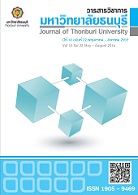ประวัติศาสตร์ชุมชนมุสลิมฝั่งตะวันตกของแม่น้ำเจ้าพระยาสมัยรัตนโกสินทร์ถึงปัจจุบัน ศึกษาพื้นที่บางกอกน้อยและบางกอกใหญ่
Keywords:
ประวัติศาสตร์ชุมชน, ชุมชนมุสลิม, Community history, Muslim community,Abstract
การวิจัยครั้งนี้มีวัตถุประสงค์เพื่อศึกษาถึงภูมิหลัง พัฒนาการทางประวัติศาสตร์ วิเคราะห์ถึงสถานภาพ บทบาท กระบวนทัศน์การปรับตัวและการธำรงความเป็นมุสลิมภายใต้บริบททางประวัติศาสตร์ชองชุมชนมุสลิมฝั่งตะวันตกของแม่น้ำเจ้าพระยา โดยเป็นการวิจัยเชิงประวัติศาสตร์และนำเสนอในรูปแบบวิเคราะห์เชิงพรรณนา
ผลการศึกษาพบว่า ชุมชนมุสลิมริมฝั่งตะวันตกของแม่น้ำเจ้าพระยามีพัฒนาการทางประวัติศาสตร์มาตั้งแต่ครั้งกรุงศรีอยุธยา ด้วยปัจจัยสำคัญคือลักษณะทางภูมิศาสตร์และประวัติศาสตร์ แบ่งออกเป็นนิกายซุนนีห์และชีอะห์โดยมี ศาสนสถานเป็นศูนย์กลางของชุมชน และเป็นกลุ่มคนที่มีบทบาทสำคัญทั้งด้านการค้าสังคม วัฒนธรรม และการรับราชการ ในสมัยรัตนโกสินทร์ ชุมชนมุสลิมคือกลุ่มชาติพันธ์หนึ่งที่ร่วมผ่านบริบททางประวัติศาสตร์ทั้งการทำการค้ากับตะวันตก การปฏิรูปประเทศ การเปลี่ยนแปลงการปกครอง สงครามมหาเอเชียบูรพา รวมถึงการเป็นชุมชนมุสลิมในท่ามกลางวัฒนธรรมชาวพุทธ บริบทเหล่านี้ส่งผลทั้งทางตรงและทางอ้อมต่อชุมชนมุสลิมในพื้นที่ นำมาซึ่งกระบวนทัศน์การปรับตัวเพื่อการธำรงอัตลักษณ์ความเป็นชุมชนมุสลิมที่แสดงออก เช่น การแลกเปลี่ยนพื้นที่ของชุมชนมุสลิมกับการสร้างสถานีรถไฟบางกอกน้อย การเกิดขึ้นของโรงเรียนราชการุญ การเข้าไปมีบทบาททางการเมืองของกลุ่มผู้นำ ความสัมพันธ์ที่มีต่อราชสำนัก การสร้างพื้นที่และตัวตนของแขกเจ้าเซ็น เป็นต้น สิ่งสำคัญคือพลังในวิถีของชาวมุสลิมเองที่มีความเข้มแข็งด้วยสายสัมพันธ์ของชุมชนที่มีต่อกัน ประกอบกับการยึดมั่นในหลักศรัทธาแห่งศาสนาอิสลามอย่างเคร่งครัด ส่งผลให้ชุมชนมุสลิมในพื้นที่ฝั่งตะวันตกของแม่น้ำเจ้าพระยาสามารถธำรงอัตลักษณ์ความเป็นชุมชนมุสลิมมาได้จนถึงปัจจุบัน
HISTORY OF MUSLIM COMMUNITIES OF BANGKOK NOI AND BANGKOK YAI AREAS ON THE WEST BANK OF CHAO PHRAYA RIVER DRUING THE RATTANAKOSIN PERIOD UP TO PRESENT
This research aimed to study background and historical development, to analyze status, role, and adaptive paradigm, and the maintaining of Islamic identity under historical context of Muslim community on the west bank of Chao Phraya river. This historical research was presented in terms of descriptive analysis.
The findings revealed that the Muslim community on the west bank of Chao Phraya river has had historical development since Rattanakosin era. With geographical and historical factors, it could be divided into Sunni and Shi’a, in which mosques were regarded as the center of community. These Muslims have had the major roles in terms of business, society, culture and public service in Rattanakosin era. Muslim community is an ethnic group that had the historical context on doing business with the Westerners, on national reforms, on political revolution, on the greater East Asia war including on being the Muslim community among Buddhist culture. This context directly and indirectly affected the Muslim community in the given areas that brought about the adaptive paradigm in order to maintain the Muslim identity. For example, the land exchange between the Muslim community and Bangkok Noi’s train station, the founding of Rachakarun school, the political participation of the leader groups, the relationship with palace, and the creating of social space and identity of Muslim Chao sen The important thing is the power of strong relationship among the Muslims in community. Also, they hold the firm belief of Islamic principles, consequently, the Muslim community on the west bank of Chao Phraya river has been able to maintain their identity







